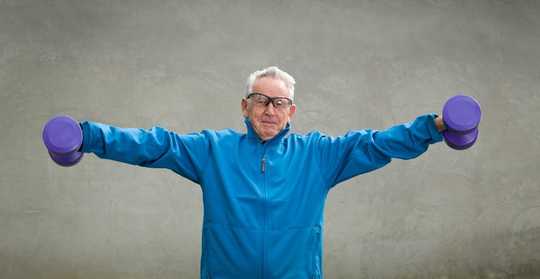It can be hard to include exercise in our busy lives, despite the best of intentions. There are a lot of reasons people don’t exercise, and a lot of misconceptions about exercise. Here are nine common misconceptions about exercise and what research actually tells us.
1. I was fit once, so I don’t need to exercise
Unfortunately, the health benefits of exercise won’t last if you don’t sustain your exercise regime. A significant reduction or drop out can cause a marked loss of initial benefits, such as cardiovascular fitness and endurance. Consistency is the key. Mix it up and keep it interesting as maintaining high levels of physical activity throughout your life is associated with the best health outcomes.
2. Being on your feet all day doesn’t have the same benefit as exercise
Being on your feet, moving around all days means you have a high level of physical activity. This is health enhancing. To optimise health benefits, increase your level of exercise – enough to cause you to sweat a little – to at least 150 minutes a week, where possible.
3. Exercise needs to be ten minutes or longer, otherwise it’s a waste of time
The good news is that recent guidelines have eliminated the need for physical activity to be delivered in bouts of at least ten minutes. There is no minimum threshold for health benefits, so carry out active daily chores, such as carrying heavy shopping bags and vigorous house or garden work, to improve your health.
Try to do exercise “snacks”, for example three to five short (half a minute to two minutes) bouts of activity spread across the day, such as climbing a few flights of stairs at a high enough intensity to make you a bit out of breath.
 It all counts. Andrey Popov/Shutterstock
It all counts. Andrey Popov/Shutterstock
4. I have a chronic disease, so I should avoid exercise
This is not the case. Being more active will benefit a range of chronic conditions, including cancer, heart disease and chronic obstructive pulmonary disease. Be as active as your condition allows, aiming for 150 minutes a week of moderate activity if possible. If you have complex health needs, seek medical clearance from a doctor before you start a new exercise regime and get exercise advice from a physiotherapist or other exercise professional.
5. I’m too old to exercise
This is not true. Evidence shows that ageing alone is not a cause of major problems until you are in your mid-90s. And strength, power and muscle mass can be increased, even at this advanced age. Ideally, include aerobic exercise, balance training and muscle strengthening if you are 65 years or older.
6. Exercise will make me thin
Not necessarily. Combine calorific restriction with physical activity for more successful weight loss and remember: you cannot outrun a bad diet. People who have substantial weight loss goals (over 5% of body weight) and people trying to keep a significant amount of weight off may need to do more than 300 minutes a week of moderate-intensity activity to achieve their goal. Include resistance work to build lean body mass.
7. I run once a week, but that’s not enough
Rest assured that any amount of running, even once a week, results in important health benefits. If you don’t have much time to exercise, even as little as 50 minutes of running once a week at a pace slower than 6mph (9.65km/h) has been shown to result in a decrease in the risk of premature death. Higher levels of running do not necessarily improve the mortality benefits.
8. I’m pregnant, so I need to take it easy
Moderate-intensity physical activity is safe for pregnant women who are generally healthy and poses no risk to the wellbeing of the foetus. Physical activity decreases the risk of excessive weight gain and gestational diabetes during pregnancy.
 Exercise can help prevent gestational diabetes. Pressmaster/Shutterstock
Exercise can help prevent gestational diabetes. Pressmaster/Shutterstock
9. I’m not feeling well, I shouldn’t exercise
If you have a fever, are acutely unwell or are experiencing high levels of pain or exhaustion, don’t exercise. In most other cases, being physically active is safe, but listen to your body and decrease your exercise load if you need to. And if you can, get dressed and moving as soon as possible to avoid “PJ paralysis”.![]()
About The Author
Julie Broderick, Assistant Professor, Physiotherapy, Trinity College Dublin
This article is republished from The Conversation under a Creative Commons license. Read the original article.
Books on Fitness and Exercise from Amazon's Best Sellers list
The Four-Pack Revolution: How You Can Aim Lower, Cheat on Your Diet, and Still Lose Weight and Keep It Off
by Chael Sonnen and Ryan Parsons
The Four-Pack Revolution presents a total-life approach for attaining health and fitness goals without the hard work and suffering.
Click for more info or to order
Bigger Leaner Stronger: The Simple Science of Building the Ultimate Male Body
by Michael Matthews
If you want to build muscle, lose fat, and look great as quickly as possible without steroids, good genetics, or wasting ridiculous amounts of time in the gym and money on supplements, then you want to read this book.
Click for more info or to order
The Women's Health Big Book of Exercises: Four Weeks to a Leaner, Sexier, Healthier You!
by Adam Campbell
The Women's Health Big Book of Exercises is the essential workout guide for anyone who wants a better body. As the most comprehensive collection of exercises ever created, this book is a body-shaping power tool for both beginners and longtime fitness buffs alike.
Click for more info or to order
Bodyweight Strength Training Anatomy
by Bret Contreras
In Bodyweight Strength Training Anatomy, author and renowned trainer Bret Contreras has created the authoritative resource for increasing total-body strength without the need for free weights, fitness machines, or even a gym.
Click for more info or to order
The Men's Health Big Book of Exercises: Four Weeks to a Leaner, Stronger, More Muscular You!
by Adam Campbell
The Men's Health Big Book of Exercises is the essential workout guide for anyone who wants a better body. As the most comprehensive collection of exercises ever created, this book is a body-shaping power tool for both beginners and longtime fitness buffs alike.



























